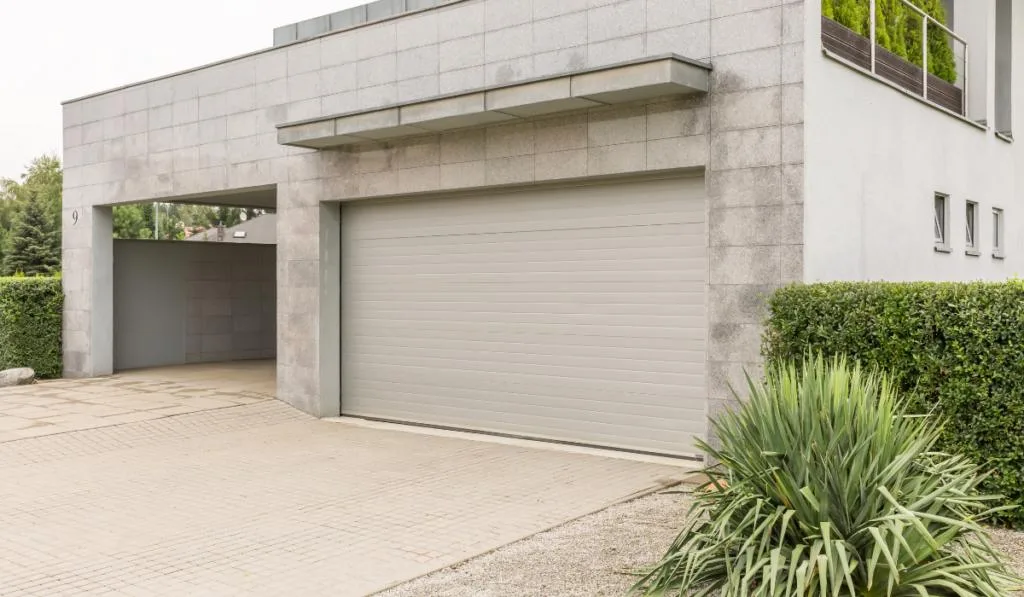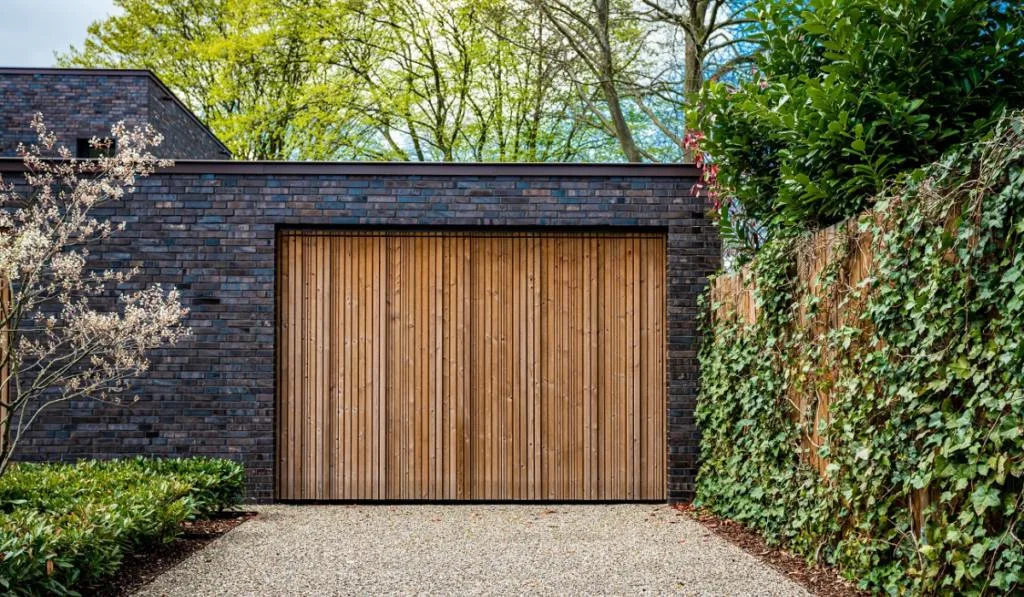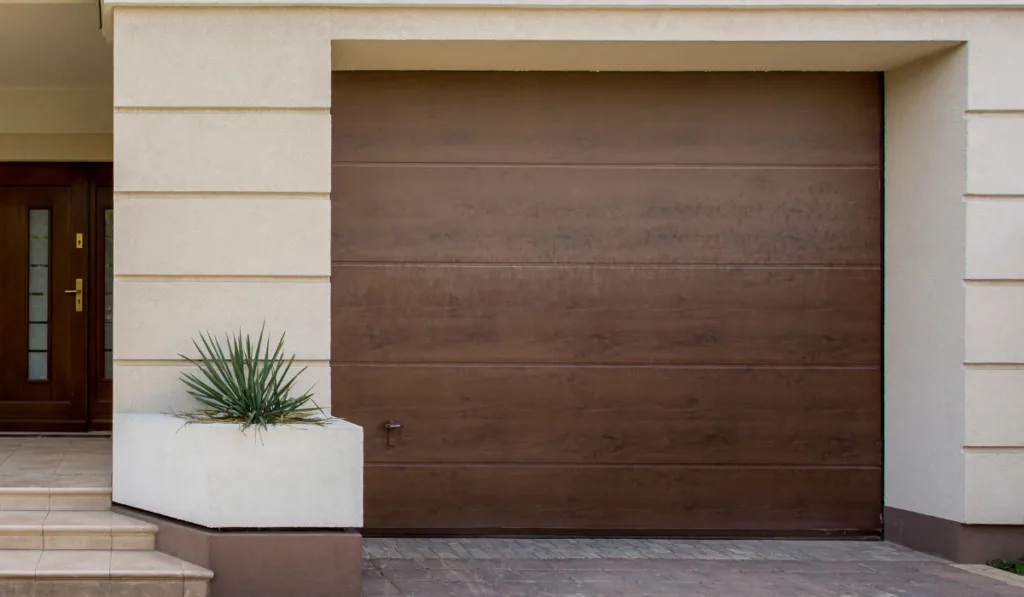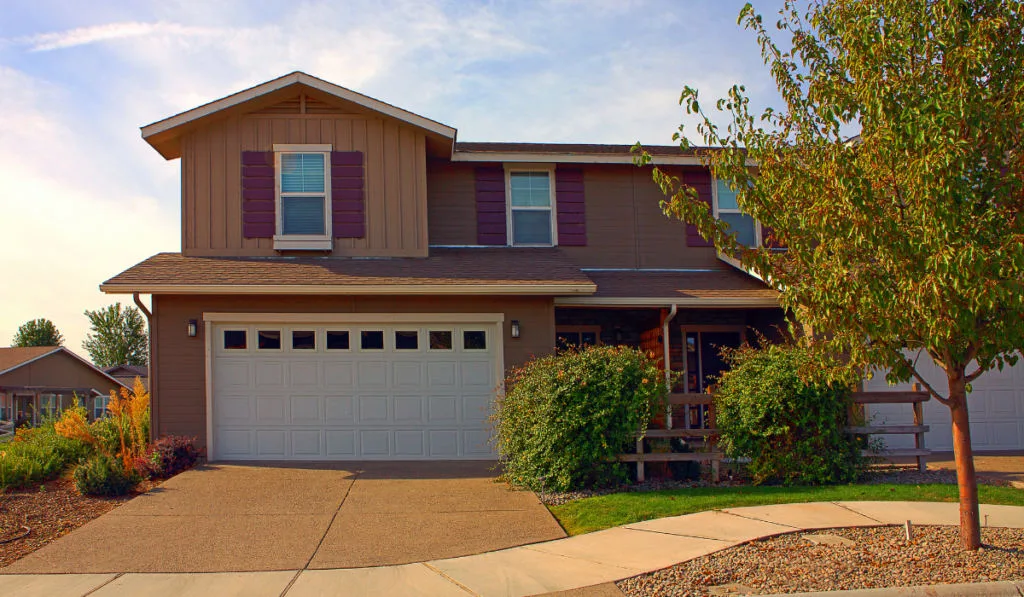*This post may have affiliate links, which means I may receive commissions if you choose to purchase through links I provide (at no extra cost to you). As an Amazon Associate, I earn from qualifying purchases. Please read my disclaimer for additional details.
The garage door is often the first feature people notice when they look at a home. All too often, this door is pre-manufactured and bland, looking just like every other house on the street. If you want something distinctive, you can get custom-made doors – for a very high price. Is there any other option besides dull and expensive? Yes – you can build your own garage door!

Building a garage door isn’t difficult for someone with basic woodworking skills. If you can measure and cut lumber, screw or nail together frames and panels, and attach everything to a building – you can build a garage door!
Table of Contents
Things to Consider When Building Your Own Garage Doors
There’s an old saying among builders – “fast, good, or cheap – you can pick two.” Building your garage door is like that.
If you want a basic door, you can create one fast and cheap. If you want something genuinely fancy, it will take a while. An ornate door will also be expensive, although it will cost less to build one than to have someone else custom make it.
Cost
You can build a garage door for less money than a store-bought door of similar quality, but you can’t make one for no cost at all. If you have tools already, you just need to buy materials. Adding equipment to your shopping cart will increase the price of the project dramatically.
A fancy door will cost more because the materials are more expensive. Dimensional lumber costs more than sheets of plywood; decorative hinges and hardware cost more than the plain ones. Adding trim, windows, and paint adds even more cost. Still, building your own carriage house door is cheaper than finding a master carpenter to do it for you.
Quality

The quality of the door depends entirely on your skills as a builder. If you can build high-quality furniture, you can even build fancy carriage house doors. If your skills are more limited, you may want to stick to a basic door frame with sheathing. Either way, it is possible to build a sturdy garage door that will last for years.
Time
If you need a door today to seal up your garage, building one yourself is probably not the best route. It takes time to make a sturdy, attractive door. Building a garage door works best when you have enough time to work on it.
Time requirements double for fancy doors – allow plenty of time if you are building carriage house doors or other architectural wonders.
When something happens to your existing door that requires immediate replacement, your best bet might be a trip to the home center for a pre-made door. That will get the hole sealed and your home secured in a jiffy. The best situation for building your door is to replace one that’s ugly or doesn’t work well, but still closes. You have plenty of time to work on your new door and get it right before installing it.
Size, Material, Shape
Your existing garage will determine the size and shape of the door you need.
Measure the doorway and match the door to that. Measure all four sides of the opening if you have an older home. Sometimes houses sag and shift – a perfectly square door won’t look right in an opening that’s a little off.
If your door opening isn’t square, you can try to fit the door to the doorway, or you can try to square the hole. Fixing a sagging garage that is no longer square is a significant project. That’s beyond the scope of this article, but it is a possibility.
Check the walls to make sure they are level and check the floor to see if the foundation has shifted. There are ways to fix both, but it might be easier to make the doors a little off square. Such doors will look good in a doorway that isn’t square.
Material

The most common type of garage door has a stamped metal frame and sheet metal sheathing. This technique produces a door that is strong, light, and inexpensive.
You probably can’t match the weight of the stamped metal frame. The best framing material for most home builders is 2×2 or 2×4 lumber. This lumber is strong enough to make a sturdy door but light enough that you can lift it.
The sheathing can be sheet metal or plywood. Sheet metal is lighter and a little cheaper, but hard to customize. Plywood (make sure to use exterior grade!) is heavier but easier to shape.
If you want a door that looks like a carriage house door or something fancy like that, you must use dimensional lumber.
Weight vs. Strength
Building a garage door becomes a balancing act – the door must be strong enough to handle years of opening and closing without warping or sagging. It must also be light enough to open and close, particularly if you are required to hoist it overhead. If you must choose between light and durable, choose light (unless your name is Arnold or Hulk). A light door will eventually wear out; a heavy door will be hard to open forever.
Welders Have Choices
If you have access to welding equipment, you have a little more choice in building your door frame. You can weld a door frame from square tubing that’s both stronger and lighter than an equivalent lumber frame. The materials cost is about the same, but the door will be much more durable.
Sadly, this option is only cost-effective if you already have a welder. Buying the equipment to weld up a garage door puts this project into the same price range as a custom-made wood door.
Choosing Between Segmented Doors or a One-Piece Door
There are several different shapes for your new garage door. Each has advantages and disadvantages; some work better in tight quarters, while others need space to open. Some are easy to build and hang, while others are difficult.
One-Piece Doors
One-piece doors (also called “single panel”) consist of a single panel. Contrary to the name, they aren’t one piece of wood. However, these doors act as a single unit; the door doesn’t fold or hinge in any way.
One-piece doors are the easiest to build and hang. One-piece doors have two drawbacks. First, they require lots of space to open. Second, they are likely to sag in the future.
One-piece doors can be side-hinged or sliding. Side-hinged doors work just like the doors in a house – they swing open from the side. If you live in a snowy area, you will have to shovel snow away from these doors before you can open them.
Sliding doors require you to mount a track along the wall. They can’t be blocked, but they need a stretch of wall as wide as the door to allow the doors to open.
You can also make a one-piece overhead door, although these are uncommon now. These doors require more room than a roll-up door, but less than a swinging door. One-piece doors are beautiful if you are style-conscious; you can build these doors to match any style of house.
Segmented Doors
Segmented doors are built of two or more elements that are hinged together. The most common type of garage door is the segmented roll-up door. These doors have three to five sections that are stacked vertically. The door rolls up a track; the hinges let the door bend as it rolls up the track.
Bi-fold doors are horizontal garage doors that fold in the middle. This style of door is typical for closets inside the house. Bi-fold doors are more compact than swinging doors but don’t require a particular track or hinges to install. However, due to the number of hinges, this style of entry can be tricky to operate.
Garage Door Material Options
If you are buying garage doors, there are lots of materials available. Steel and wood are the most common, but doors made of composite material and vinyl are also available. If you are building your own door, you are pretty much limited to wood. Steel might be an option if you can weld, but it’s tough to imagine a welded steel door as light and cheap as a store-bought door that uses lots of stamped components.
Pros and Cons of Building vs. Buying
Like any do-it-yourself project, there are a lot of factors to consider when choosing to build or buy. Each option has both good and bad points. The weighting of each item is up to you; what is vital to one person might seem silly to another.
Buying a Pre-Made Door
Pre-made doors are available at most home centers around the country. These doors are available in a wide variety of colors and styles. Even if you are a die-hard DIYer, there are some excellent reasons to buy a garage door.
Pros of a pre-made door
- Time: it’s always faster to buy a pre-made item than to build it yourself
- Quality and warranty: pre-made doors are built to standard sizes, and they are done right. If there is a problem with your door, most come with some type of warranty.
Cons of a pre-made door
- Style: you are limited to the styles and colors chosen by the manufacturer
- Cost: these doors aren’t cheap, and many (especially roll-up doors) require professional installation
Building your own
There’s always a satisfaction found in building things yourself, and doors are no exception. There are plenty of other good reasons to create your own door, but there are also some drawbacks.
Pros of building your own garage door
- Flexibility: if you need an oddly-sized door, it has to be custom-made
- Style: you can make a garage door to match any style of home – provided that you are a good enough craftsman
- Cost: when it comes to custom work, doing it yourself is almost always the least expensive route
Cons of building your own garage door
- Difficulty: if you want something genuinely fancy, your skills might not be up to the task
- Time: you can have a store-bought door hung up, closed, and locked in less time than it takes to build a door
- Installation: garage doors are big and heavy; you will need plenty of help to hang one yourself. If you create a segmented door, you still need to call a pro to hang it and set up the spring.

Tools for Building a Garage Door
To build any style of garage door, you will need a few tools. These tools will guarantee that your door is square, fits the hole, and sturdy enough to last for years. Most of these tools are useful for a variety of projects. If you don’t have some of these tools, don’t be shy about buying them – they will help you with projects for years to come. Here are the must-have tools for a garage door:
- Measuring tape-this is a standard for DIY projects
- T-square or speed square-you will need a metal square to guarantee your door isn’t skewed
- Circular saw-another DIY standard; a circular saw is one of the handiest power tools you can get
- Power drill-it’s possible to screw a door together with a hand-held screwdriver, but we don’t recommend it.
- Hammer for nailing the sheathing on the door
- Tin snips-if you are using sheet metal for the door facing, you will need a tool to cut the metal
- Caulking gun to seal up the joints nice and tight
- Painting equipment to make your door pop
If you would like to make the project a little easier, or if you just have a hankering to buy tools (and what DIYer doesn’t?) here are a few more that can make the project even easier:
- A power miter saw for cutting lumber to length – even at an angle
- Pneumatic nail gun and air compressor – use one of these for a while, and you’ll never go back to hammering again
- Jigsaw if you want to cut arches or other complex shapes in the door
- Power tin snips if you’re going to cut sheet metal faster
Supplies to Get Started with a Segmented Door
To build a segmented door, you make each piece separately, then hinge them together and add rollers. The supplies you need are:
- Framing lumber 2×2 is the best combination of lightweight and strength, but it can be hard to find. 2×4 is more cumbersome, but will also work (especially if you have a garage door opener)
- Door facing can be plywood, sheet metal, or dimensional lumber
- Hinges to connect the sections
- Rollers that fit the track in your garage or
- Pins hinges for bi-fold doors
- New track if you don’t have one already, or the old track was damaged
- Windows or glass panes if your door plan includes a source for light
- Paint or stain for the finished door
- Trim may or may not be needed; you can pretty up your entry by adding some trim or just leave it plain. That’s up to you.
Pro tip: make sure your panels are square by measuring the diagonals before nailing the frame together. The two diagonal measurements should be the same; if they aren’t, adjust before you nail everything together
Hanging a Roll-Up Door
Roll-up doors are usually attached to a wound spring that helps counteract the weight of the door. You can build and mount a roll-up door yourself, but you probably can’t connect the spring without help. Roll-up door springs require specialized tools and skills that even the most hard-core DIYer doesn’t have. You will probably have to call a pro for this task.
Supplies to Get Started with a One-Piece Door
The supply list for one-piece doors is similar, but there are a few differences.
- Framing lumber You can use 2×4 lumber for a one-piece door; there are fewer frame elements so that the lumber can be a little heavier.
- Door facing since the panels are bigger, you can get a little more creative – use decorative elements like X-bracing for a barn door look
- Windows or glass panes if your door plan includes a source for light
- Hinges or mounting hardware for the design you need different hardware for side-opening, top-opening, or roller doors; make sure to get the right ones
- Paint or stain – use two colors for a barn-door look
- Trim can be used to add some flair to your new door if you like, though plain doors are excellent too.
Conclusion
Building your own garage door is a project that can challenge any do-it-yourselfer, from a novice to the most advanced carpenter. You can create a sturdy door in a wide range of types and styles to match any décor. The tools and materials needed for this project are simple; most DIYers will already have some or all of the tools required.
If you are tired of your bland sheet metal garage door, start dreaming! Check out fancy doors on the internet and look for plans. Building a lovely new garage door is easier than you think – try it soon!
Resources
- https://home.howstuffworks.com/home-improvement/how-to-build/how-to-build-garage-door.htm
- https://www.ehow.com/how_2383286_build-garage-doors.html
- https://www.familyhandyman.com/doors/garage-door-repair/garage-door-makeover/
- https://www.thespruce.com/single-panel-vs-sectional-garage-doors-1398094
- https://homeposh.com/swing-out-garage-doors-how-to-build-in-three-steps/
